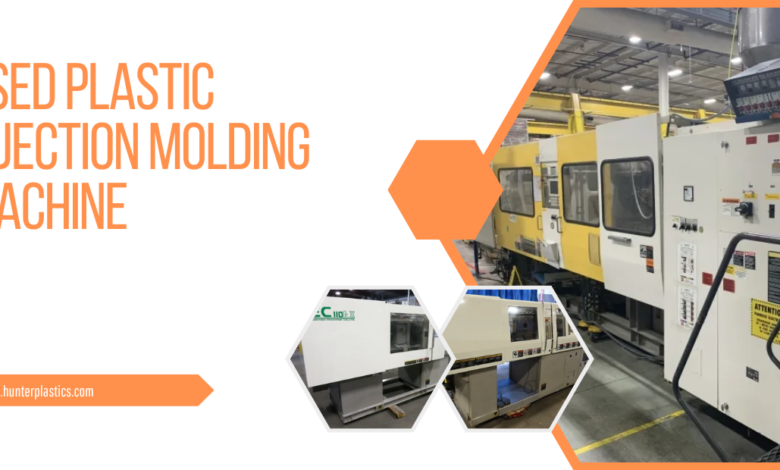How to Inspect a Used Injection Molder Before Purchase

When buying a used injection molder, thorough inspection is essential to ensure you are making a sound investment. Pre-owned equipment can offer great value and cost savings, but the risk of wear and tear or missing parts cannot be overlooked. A comprehensive inspection will help avoid unexpected breakdowns and ensure smooth operations. In this guide, we will walk you through key steps to inspect a used injection molder and its components. We will also highlight what to look for in Used Injection Molder Parts to ensure quality and durability.
1. Check the Machine’s Overall Condition
The first step in inspecting a used injection molder is to evaluate its exterior condition. Look for signs of corrosion, cracks, leaks, or wear on critical components. A well-maintained machine should not have excessive rust or visible damage. If the equipment looks neglected, it may indicate poor upkeep by the previous owner.
Tips for Inspecting the Exterior
- Check for oil leaks near hydraulic components.
- Inspect the frame and housing for cracks or dents.
- Ensure that safety guards and covers are in place.
A machine’s appearance can give you a good indication of how it was maintained and whether it will require major repairs.
2. Evaluate Key Mechanical Parts
The performance of an injection molder depends heavily on several key mechanical components. These include the clamping unit, screw, barrel, and mold platens. Any defect in these parts could affect the machine’s ability to operate efficiently.
Components to Inspect
- Clamping Unit: Check if the clamping force is consistent. Worn-out tie bars or bushings can cause misalignment.
- Screw and Barrel: Inspect for signs of wear, as these are prone to abrasion over time. If the screw flights are damaged, it will affect plasticizing.
- Mold Platens: Ensure the mold platens are flat and free of cracks or uneven surfaces.
- Hydraulic Pumps: Verify that the hydraulic system operates smoothly without any unusual noises or pressure drops.
Ensure that used injection molder parts, such as the screws and clamps, are still in good working condition, or you may need to replace them soon after purchase.
3. Inspect Electrical Systems and Controls
Modern injection molding machines rely heavily on electrical controls for precise operations. If you’re purchasing a used machine, it’s critical to verify that all electrical components are functioning properly.
What to Inspect in Electrical Systems
- Control Panel: Make sure the display is clear and responsive. Test all buttons and knobs for functionality.
- Wiring: Look for any frayed or damaged wiring, which can be a safety hazard.
- Motors and Drives: Test the motors to ensure smooth operation without unusual sounds.
- Safety Interlocks: Check if safety interlock systems are intact to prevent accidents during operation.
Malfunctioning electronics can lead to operational delays and require costly repairs, so this step should not be overlooked.
4. Review the Machine’s Service History
One of the best ways to assess the reliability of a used injection molder is to review its service and maintenance history. Machines that were regularly serviced are likely to perform better over time.
Key Records to Check
- Maintenance Logs: Look for consistent records of preventive maintenance.
- Repair History: Identify any major repairs or component replacements.
- Replacement Parts: Ensure that any used injection molder parts installed are from reputable manufacturers.
A thorough service history can reveal whether the machine has experienced chronic problems or if it has been properly maintained by previous users.
5. Test the Machine Under Real Conditions
Whenever possible, it is advisable to run the machine in a real production environment before finalizing the purchase. This test run allows you to evaluate the machine’s performance under pressure and identify potential problems that may not be obvious during a visual inspection.
What to Look for During a Test Run
- Cycle Time: Ensure that the machine cycles efficiently and meets production speed requirements.
- Part Quality: Inspect sample parts to ensure consistency and precision in molding.
- Noise Levels: Listen for unusual sounds from motors, pumps, or bearings.
- Temperature Control: Verify that the heating and cooling systems function correctly.
Testing the machine allows you to detect hidden issues, giving you peace of mind before purchase.
6. Assess the Availability of Spare Parts
When buying a used injection molder, the availability of spare parts plays a crucial role. Older machines may have limited access to replacement components, which can lead to downtime if something fails. Make sure you can source used injection molder parts easily and at a reasonable cost.
Tips for Checking Spare Parts Availability
- Identify the machine’s model and manufacturer to verify part availability.
- Contact suppliers for a list of commonly replaced parts, such as screws and seals.
- Confirm whether compatible parts from other manufacturers are available.
Having access to spare parts will reduce the risk of prolonged downtime and help keep your production line running smoothly.
7. Get an Expert Opinion
If you’re not familiar with the technical aspects of injection molding machines, consider hiring an expert to assist with the inspection. An experienced technician can identify potential issues that might be missed by an untrained eye.
Benefits of Expert Inspection
- Technicians can perform detailed diagnostic tests.
- Experts can provide estimates for potential repair costs.
- They can advise on whether the machine is worth the investment based on its condition.
Hiring an expert may require an additional cost, but it is well worth the investment for peace of mind.
Conclusion
Inspecting a used injection molder thoroughly before purchase is crucial to ensuring a good return on your investment. Start by checking the machine’s overall condition and evaluate critical mechanical and electrical components. Review its service history and, if possible, conduct a test run to assess performance. Additionally, make sure that spare Used Injection Molder Parts are available to avoid downtime.
By following these steps, you can confidently select a reliable used injection molder that will meet your production needs and offer long-term value. With proper inspection, you can avoid costly repairs and ensure smooth operations, making your investment worthwhile.





